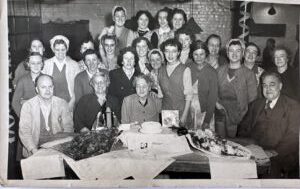Introduction
The north of England is commonly associated with images of heavy industry, with the industrial
revolution crucial in the construction of the northern sense of place. Some historians argue that
industrialisation was the making of the English working class. Therefore, deindustrialisation not only
meant damaging effects for the economy, but also for the community and identities created from working in these industries. Oldham was once the heart of industry in the production of cotton and textiles, which made finding a job particularly easy. After deindustrialisation, mills closed down, one after another, and people were being made redundant. This significant economic change in British history contributed to serious transformations for local communities in the north of England, including rising unemployment, poverty and urban decay. This brings into question did deindustrialisation make or break Oldham’s
community solidarity?
Textiles Industry in Oldham (Prior to Deindustrialisation)
Oldham was once one of the wealthiest towns in the world, with employment in the mills peaking at more than 50,000 at the beginning of the twentieth century. It is safe to say Oldham’s history has revolved around the production of cotton textiles. Northern identity in towns such as Oldham included qualities of independence, dignity of labour, and solidarity both at work and in the community. People made connections and friends by going to work in the mills, which created the sense of community. It was women that made up the majority of the cotton industry’s workforce until the 1960’s and they were particularly dominant in weaving and spinning. This work gave women a sense of self, and a purpose outside the home. Many people involved in the project spoke of either their parents or themselves having worked in the cotton mills. Peggy Cooke spoke about how her whole family and all her friends had worked in the mills. It was the prominent workplace after people had finished school. However, it wasn’t the only line of work available: ‘you could jump in one job, and if you didn’t like it, you could jump in another’.
Deindustrialisation Effects
However, from the 1950s, textile production in Oldham, like many other northern industrial towns, began to decline. A resident remembers getting a job at Warwick Mill, it closed down and she was made redundant. She got a job at Hartforth Mill, it was closed down, and she was made redundant again. The textile industry in Oldham was in crisis, with 11 mills closing in 1980, cutting the size of the town’s industry by thirty per cent. Between 1971 and 1991, 15,000 jobs in the Oldham textile industry
disappeared. As working-class white women have long been the centre of Oldham’s textile industry, they were badly affected by this dramatic collapse, not only in terms of unemployment, but mass cuts to welfare and social services, including health and child care. This collapse of the town’s industrial base has now meant Oldham is one of the most deprived local authorities in England.
What is Oldham like Today? – Community
There is a widespread feeling that something was lost in the decades of deindustrialisation and
Thatcherism. The face-to-face working-class communities of the mid-twentieth century, that depended on the unpaid labour of women, would be difficult to recreate in a post-industrial context. Although the collapse of the textile industry meant a loss of the town’s main employment source, Oldham is still very much considered a tight knit community by its residents. Many of the Oldhamers interviewed as part of the project spoke positively, and there was a general consensus that people loved living in Oldham and being part of its community. Carol Taylor, who has lived in Oldham all her life, spoke about her neighbours being friendly and talkative, ‘everyone gets on in the area and people help each other out’. Peggy Cooke had a similar view of Oldham being a ‘friendly place’ with neighbours helping her. We can still see the sense of women being at the heart of the community, as they were in the textiles industry through community centres. Places like the Primrose Centre have activities such as a sewing club, run by women, where people can learn new skills, as well as making friends, which also ties nicely with Oldham’s history in textiles. Michelle Trevor talks about the centres as an opportunity to meet people and make friends: ‘Oldham has always been a close knit society, and it’s that little community hub that keeps people here feeling cosy and looked after’.

(Dorothy Sweatman from Crossley, stood by her Aunt Martha Ann who retired at the age of 75. The mill manager remarked she’d never taken a day off. Taken in 1950s in Chamber Mill in Chadderton, known locally as Th’ Owd Bog.)







